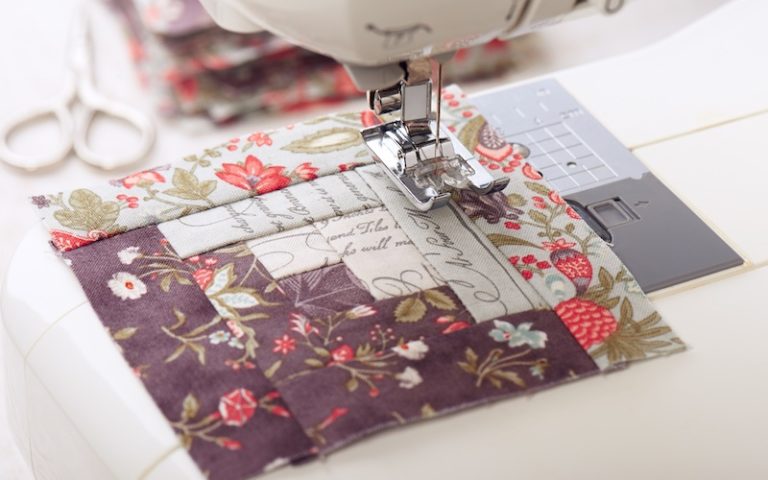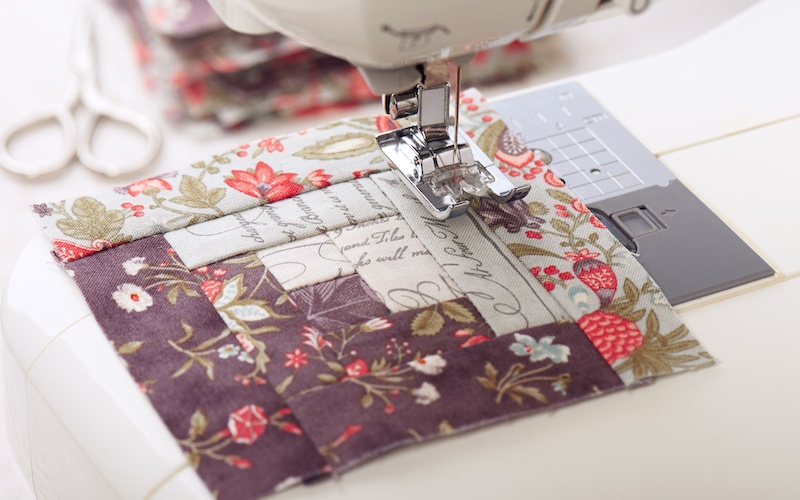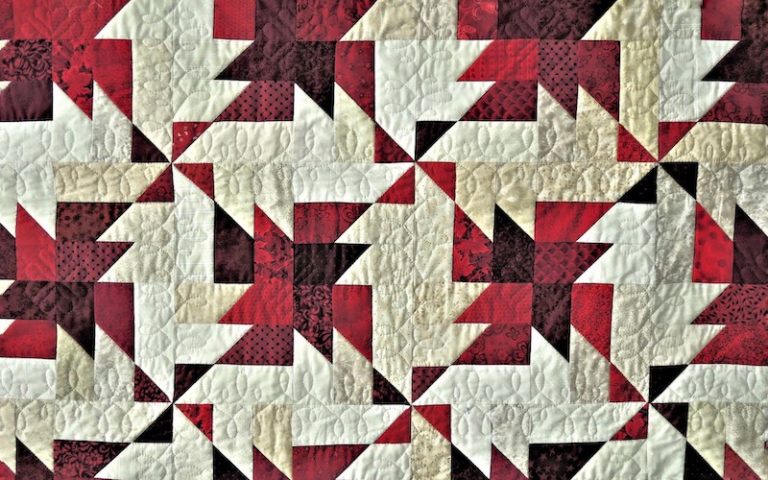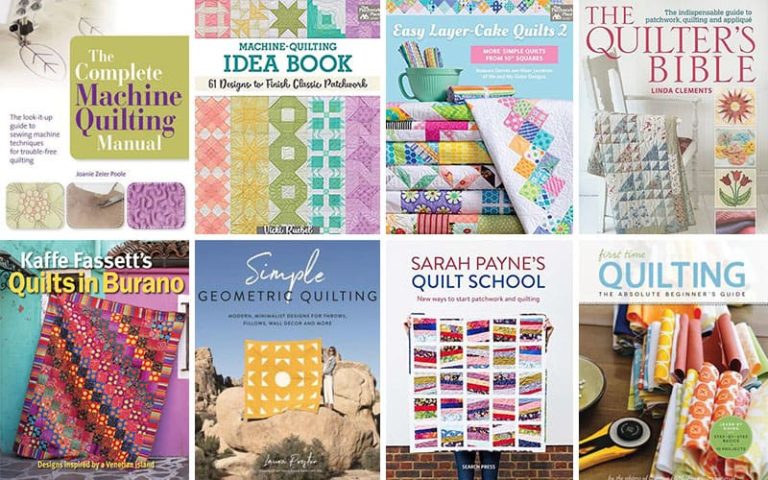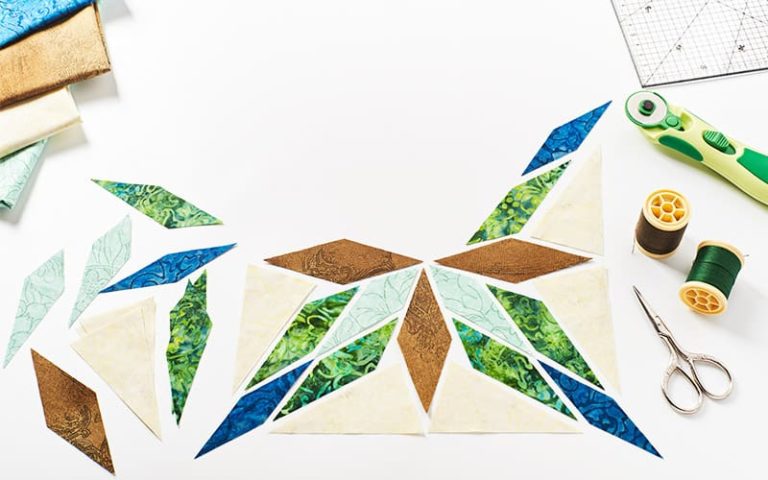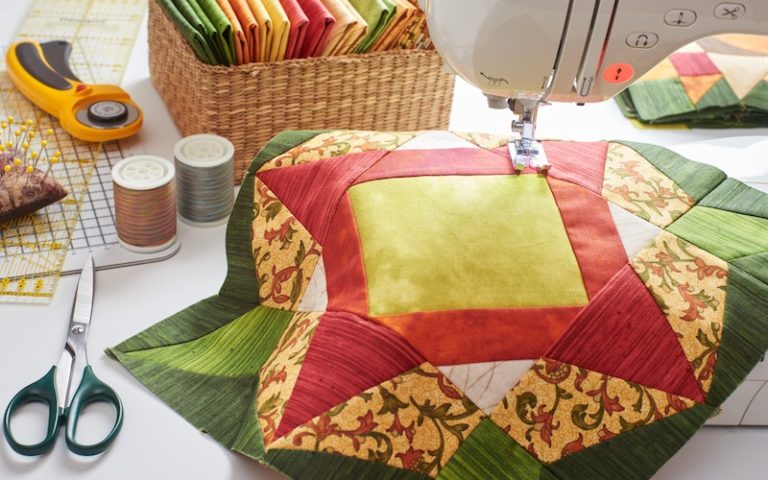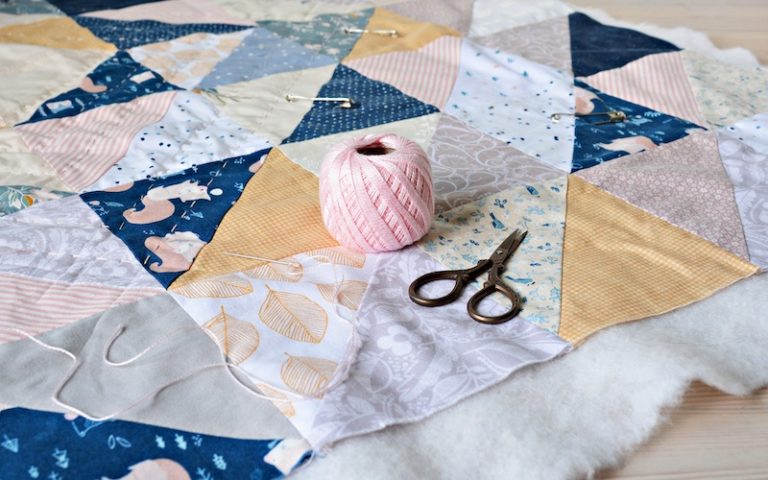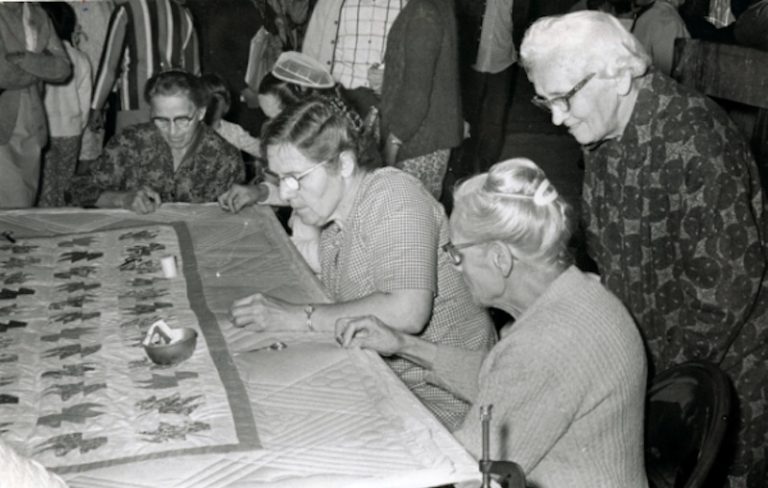The history of quilting stretches back to at least medieval times. Over the centuries, quilting became a popular way of making blankets and garments, both for home-quilters and professionals.
For the pioneers of the American West, quilting was not only a cost-effective way to make practical items, but became an important part of the culture. Women would come together to make quilts, and this was an essential aspect of community spirit.
Before the advent of the sewing machine and modern fabrics, early quilters were limited in what they could sew. Therefore, traditional quilt patterns were relatively simple but used creative ways to make designs and motifs that represented daily life at the time.
Traditional quilt patterns
There are a range of traditional quilt patterns that developed over the years and remain popular with quilters today.
We will give an overview (historic and otherwise) of eight classic quilt patterns, and recommend a tutorial for each so you can try them for yourself!
And if you want to explore the art of quilting even more, check out our review of the best books for quilting that cover a range of different styles and techniques.
Log cabin quilt
The log cabin is a classic patchwork block pattern that remains extremely popular today: this quilt block is well-known in modern quilting patterns. It was commonly used by pioneers in the American West, who saw it as a symbol of home, security, and love.
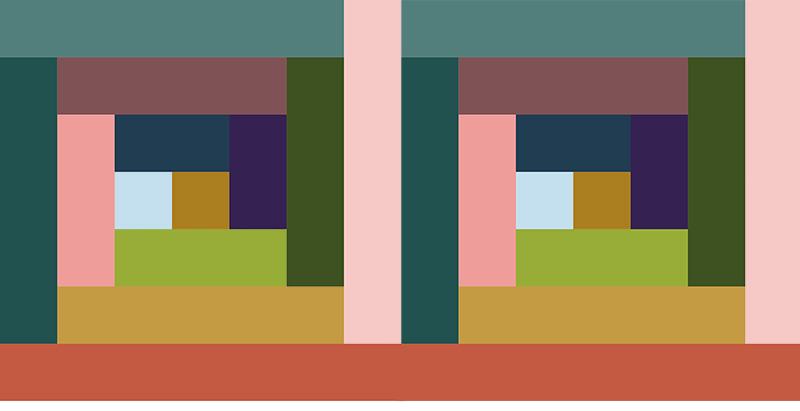
The log cabin pattern is so named because it is made with a series of strips of fabric, or “logs”. These narrow rectangles are built around a central square, adding each fabric strip the same way that logs are stacked to build a cabin.
The pattern uses strips of various sizes, making it perfect for using up old scraps of fabric. Traditionally, log cabin quilt squares use dark colors on one side and light colors on the other, representing the sun shining on one side of the cabin and adding to the visual texture.
This log cabin tutorial is perfect for beginners, or anyone wanting to make their own log cabin quilt. It details how to make this classic quilt block as well as how to create a full-sized log cabin quilt.
This tutorial uses the quilt-as-you-go method to make the quilt block. This is a simple way to work, by attaching and quilting the batting to the quilt block as you make it.
Nine patch quilt
Another popular patchwork pattern used by the pioneers, the nine patch is a simple block that can be thrown together quickly. This quick and easy way to use old pieces of fabrics to create a warm quilt was perfect for busy pioneer women.
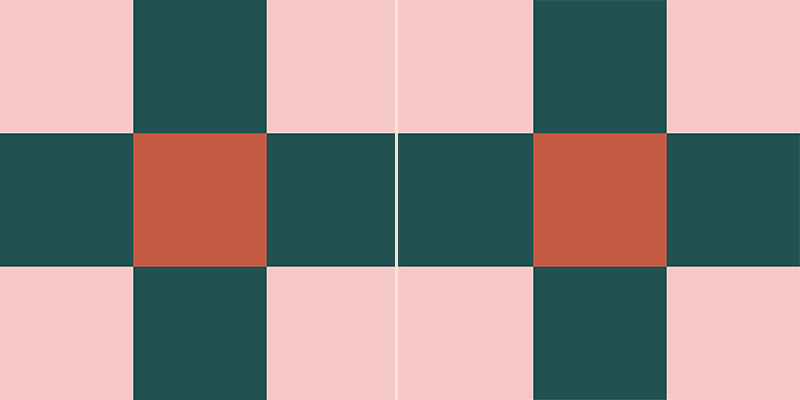
A nine-patch block, as the name suggests, is made up of three rows of three squares, creating nine equal-sized squares. This pattern is made from only small pieces of fabric, and so is ideal for using up every last scrap.
Appreciated by the early pioneers for its simplicity, the nine patch quilt is equally suitable for modern beginners. A nine patch is the perfect way to get started with quilting without needing to worry about intricate stitching.
This nine patch tutorial has a classic nine-patch pattern for free download, as well as instructions on how to create the pattern. There are various methods for making a nine patch block, but we love the one described here as quick, easy, and accurate.
The tutorial covers how to choose fabric and colors, as well as touching on how you can vary the size of the strips for a scrappy look.
Pinwheel quilt
The geometric design of a pinwheel quilt block is deceptively simple. This dynamic pattern is actually only four half square triangles.
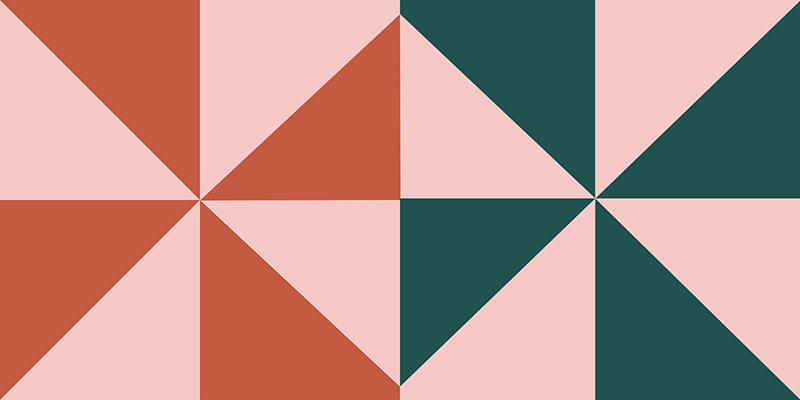
This means that beginner quilters can make a more complex-looking design while only needing to worry up simple piecing and straight lines.
The pinwheel pattern uses just two, alternating fabrics. You can choose plain fabrics in bold colors for a modern twist, or create a more traditional pinwheel using classic prints.
These quilt blocks can also be made with white and a solid color and placed on a white background to invoke pinwheels blowing in the wind, like in this vintage-style quilt pattern. The relatively-easy quilt pattern uses hundreds of pieced triangle-squares – great for practicing piecing!
The quilt is finished with a triple-colored solid border, and can be quilted according to your preference. It looks stunning in simple, vintage tones but you can play with different fabrics to create a unique look.
Eight pointed star
The star was a common motif used in traditional quilts. Not only is this an easy was to add interest to a design, but it also reflects how the early homesteaders used the stars to guide their way when traveling West.
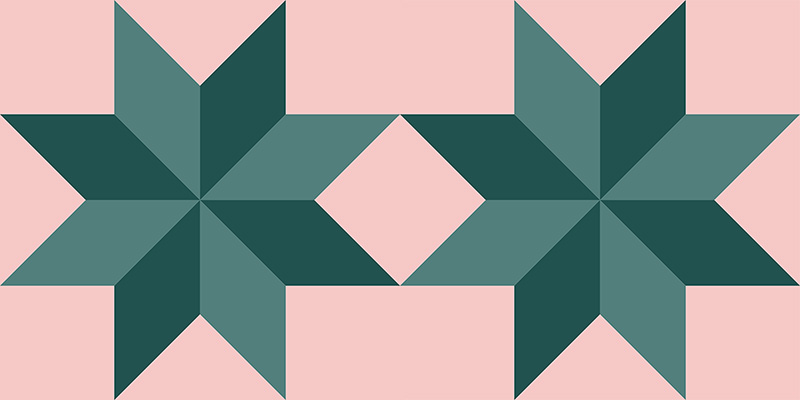
During this era, stars were also seen as a symbol of faith, so it is not surprising that the highly-religious pioneers and settlers commonly used it.
Many different star patterns were traditionally used in quilts, but the eight-pointed star was one of the most popular. This star is made with eight elongated diamonds positioned around a central point.
Traditional quilts may have featured a single large star, sometimes called a Star of Bethlehem or Blazing Star. Other quilts had a series of many smaller stars.
Although it only has straight lines, an eight-pointed star is quite fiddly to sew. It needs to be cut and pieced precisely for a smooth, flat finish.
In this way, this patchwork pattern was not only a beautiful way to decorate quilts in pioneer times, but also a way for quilters to demonstrate their level of skill.
Want to try the eight pointed star for yourself? Check out this clear and easy-to-follow tutorial.
It walks you through how to cut, piece, and sew the classic eight-pointed star quilt block. You can sew this pattern either by hand or on a sewing machine. Either way, it is an excellent way to practice accurate piecing and take your skills to the next level.
Crazy quilt
The crazy quilt pattern is just as it sounds: random and a little bit nuts. Traditionally, the crazy quilt wasn’t really a set pattern at all, and each could be completely different.
Historians believe that the crazy quilt is the oldest of all quilt patterns. Most likely, patchwork techniques developed as an economic way to make quilted projects.
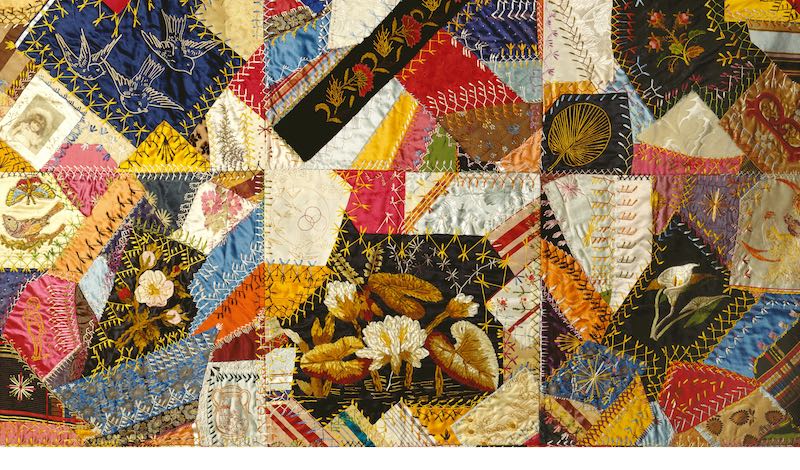
Source: Wikimedia
Quilters created quilts for warm bedding, wall coverings, or other practical purposes, reusing scraps of fabric in order to save money. They took old pieces of clothing, worn-out linens, or oddly-shaped scraps of fabric and stitched them together to create a random mass of colors and patterns.
Patchwork evolved to feature bright colors and textures, and wealthier quilters bought luxurious fabrics rather than using old scraps. As patchwork techniques were applied to create set patterns, these were shared with others and certain designs became popular.
The crazy quilt is still a fun and easy way to make an interesting patchwork design. Although the earliest crazy quilts were completely random, there are now standard “crazy quilt” patterns that are actually carefully planned to create this look.
This tutorial shows you how to make a crazy quilt design, layering fabric strips in a concentric arrangement to create a haphazard effect. Although structured, this is still a great way to use up old scraps of fabric.
Friendship quilt
The friendship quilt was highly significant for early quilters. Women typically made these quilts in to give to a friend or family member as a departing gift, perhaps ahead of them heading West as a pioneer.
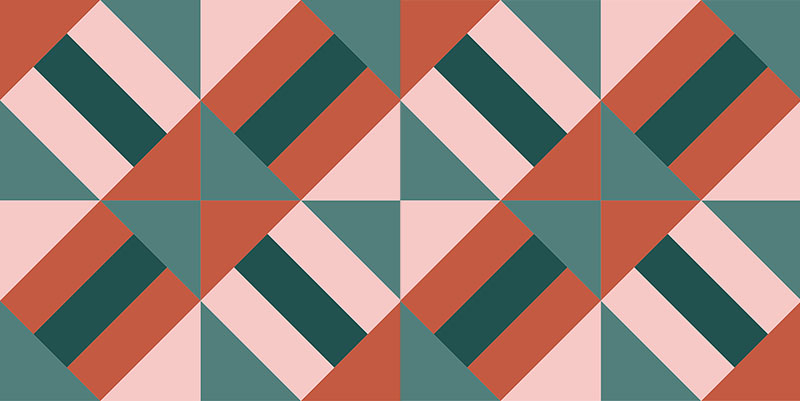
What made a friendship quilt truly special is that each quilt block was sewn by a different quilter, who then embroidered their name in the center of the block. This was a lovely way for friends and family members to show their love and best wishes to the recipient of the quilt.
If you’re part of a sewing or quilting group, you can make your own, modern friendship quilt. This friendship quilt block pattern is for 10-inch blocks that can be personalized by each quilter to create a cohesive yet individual quilt.
The blocks then need to be sewn together to and finished to create a unique and very personal gift. You could choose to make this for a special event, such as a wedding or significant birthday, or when someone is going through a tough time, as a way to show you care.
Churn dash
Unsurprisingly, the designs and patterns that pioneer women used to make their quilts often reflected the realities of their daily lives. This is certainly true of the churn dash pattern that is modeled on the shape of a milk churn, something just about every pioneer would have had in their home.
This pattern uses a series of strips and half square triangles to form a square-ish shape reminiscent of a milk churn. This pattern also went by a variety of different names, as well as multiple variations.
Most variations are simple to make and create a graphic design. You can also achieve vastly different effects depending on the number of fabrics and different colors or prints used.
This video tutorial shows you how to make a churn dash quilt from a series of churn dash blocks. It uses two layer cakes (one solid and one printed) and a white charm pack.
The relatively-simple churn dash blocks come together to form an interesting overall design with strong lines and graduating colors.
Anvil
Another quilt pattern that reflects the realities of daily life for pioneer women is the anvil. The anvil was an essential item for early homesteaders as it was used for blacksmithing, shoeing the horses that were necessary to work the land.
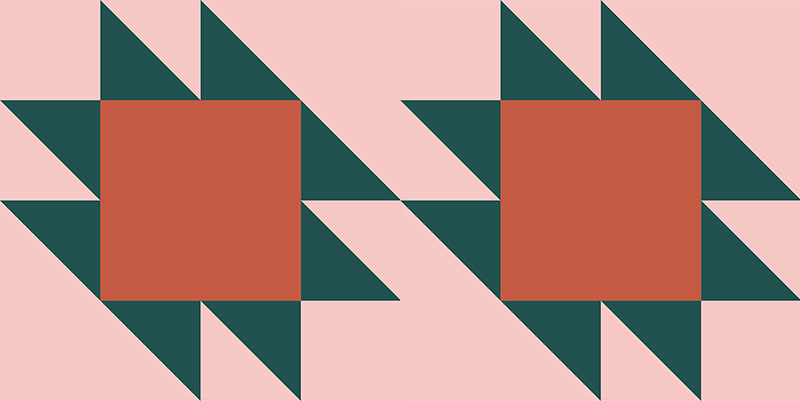
The anvil shape is created with a series half-square triangles and squares. This creates a dynamic and dramatic design, especially when using dark or bold fabrics.
The traditional anvil quilt block pattern looks equally effective placed in repeating rows of the same block, or featured with other patterns. This is also a beginner-friendly block with its straight lines and easy piecing.
This easy-to-follow tutorial breaks down how to make your own anvil quilt block, and has a pattern that is free to download from now until the end of the year.
You can create your block with a contrasting fabric in the central square, or go for a monochromatic anvil shape for a different look – it’s up to you!
Summing Up
With these tutorials, you can create your own traditional quilts, just like the ones made by pioneer women and other early quilters.
Want to sink your teeth into more quilt patterns? Check out our round-up post of modern quilt patterns and share this list of traditional quilt patterns with your networks!

